Orion Introduction
Orion Accessories
![]() News
News ![]() Products
Products ![]() Pricing
Pricing ![]() Distribution
Distribution ![]() Notes
Notes
![]()
![]()
![]() Mounts
Mounts
![]() Telescopes
Telescopes
![]()
SkyQuest™ XT10 - 10"/25.4cm Dobsonian Telescope
This model was discontinued in August 2003 when it was replaced by the new SkyQuestª XT10 Intelliscope™. But then due to popular demand for a more fundamental option, it was reintroduced as the Classic XT series in January 2004.
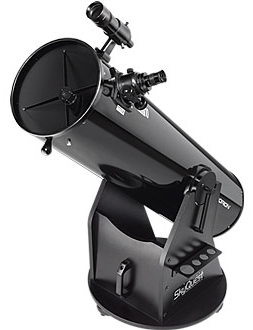 The product developed by Orion that came to dominate this area of the market,
The product developed by Orion that came to dominate this area of the market,
introducing many amateurs to their first glimpses of the deep sky wonders!
- IMPROVED OCTOBER 2002!
The Orion SkyQuest™ Dobsonian telescopes are designed for beginners who seek the best possible view of the faint Deep Sky objects while on a constrained budget. These telescope benefit from years of study and refinement of those Dobsonian style telescopes already on the market; they include advanced design and materials to keep them lightweight and simple to use. Furthermore, the accessories included are common sense items to insure a good first night out; these are items that would normally be optional for competing telescopes.
Right: Orion SkyQuest™ XT10 10"/25cm f4.9 Dobsonian Reflecting Telescope with standard 9x 50mm Finder, 2" Focuser,
Navigation Knob, 2" and 1.25" Eyepiece Holder, four vane thin profile Secondary Mirror Spider (34,859 Bytes).
Radical Resolution: The XT10 Will Dazzle You!
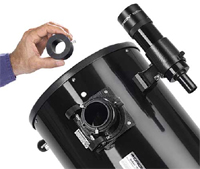 Left: Orion XT10 2" Focuser with 2" to 1.25" reducer shown (23,649 bytes).
Left: Orion XT10 2" Focuser with 2" to 1.25" reducer shown (23,649 bytes).
Click on image to see enlarged view (84,638 bytes).
Adjustable 2" Focuser Another feature of the XT10 over most other competing and smaller Dobsonian models is the standard smooth 2" focuser. This aluminum focuser accepts low magnification, wide field of view 2" eyepieces as well as the common 1.25" diameter eyepieces. The Focuser Base Plate incorporates user adjustable set screws to facilitate collimation (aligning the optical path) of the telescope. And with an optional high quality low magnification eyepiece, one could reach 23X observing areas as large as 2.1 degrees across! Keep in mind that at such a low magnification the Exit Pupil (the diameter of the cone of light coming out of the eyepiece) is 11.13mm and so this may not be as good a choice as using an eyepiece that provides 36X showing 1.77 degrees with a 7.08mm Exit Pupil. If this telescope were equipped only with a 1.25" focuser, then the maximum Field of View would be only 1.23 degrees at 31X - but with 8.1mm Exit Pupil; a more practical 32mm eyepiece would provide 1.23 degrees at 39X with a more practical 6.48mm Exit Pupil.
The factors of aperture and the 2" focuser are particularly important to people who seek better views of the extended, faint deep sky objects (nebulae, star clusters, galaxies, comets, etc.). In effect the stellar magnitude reach is extended from about 13.8 of an 8" telescope to 14.3. And still this telescope affords the contrast and clarity qualities required to observe the moon, and planets; the XT10 actually can reveals changes through out the observing season! With a comparatively small central obstruction, and fewer optical surfaces, the contrast and brightness can actually surpass more expensive designs such as some 8" and 10" Schmidt-Cassegrain telescopes.
What characterizes a reflecting telescope?: The Optical Tube Assembly (OTA) is an arrangement of the classic Newtonian reflecting telescope. An English mathematician originated this optical design although Sir Isaac Newton first made it. This system employs two mirrors. The Parabolic "Primary" mirror is the factor by which most telescopes are described; hence an 10" telescope has a primary mirror of 10 inch (25cm) in diameter. The Primary mirror of the telescope is precisely mounted in a Cell at the rear of the telescope. The light entering the telescope is gathered and then reflects forward in a converging beam, to the Secondary Mirror that is positioned near the front of the telescope. The light from the Primary mirror is then reflected out to the side of the telescope achieving focus at a point beyond the focuser. An eyepiece to enlarge the image for viewing, or a camera for photography is placed at the focuser.
Left: Pyrex® Parabolic Primary Mirror of an Orion Dobson telescope in it's Cell (16,559 bytes). Click on image to see enlarged view (68,383 bytes). 
In a departure from most imported reflecting telescopes, the Primary Mirror of the XT10 is made of Pyrex®. The American firm Corning Incorporated developed Pyrex® a well proven material which has been marketed since 1915. Pyrex® is a sophisticated borosilicate glass composition made of Silicon, Boron, Sodium and Aluminum. It provides good chemical, thermal, mechanical and optical properties. Its density (g/cm3) is 2.23. This material can be polished to provide and hold a high quality of view, and provides stability and optical performance better than mirrors in most telescopes sold anywhere near this price range. Continuing its tradition of innovation and product improvement, Orion chose to make the change from Borosilicate crown glass to Pyrex® in October 2002. The Mirror is made in China and by 2002 we became aware of how the rapid pace of modernization of industry in China was providing suppliers who could quite consistently churn out good optics at modest prices. Of course, if you wish to pay a little less then the factory can spend less time in polishing or figuring the optics or trim some cost of elsewhere. And so the same factory may manufacture a telescope that appears similar for one buyer while making it to a better specification for another. We have been quite pleased with how Orion has used its influence to engineer trendsetting products, and then have them made to a very good spec.
Among the considerations of a reflecting telescope is that the mirrors be precisely positioned within the OTA in terms of centering, tilt, and spacing. The overall alignment ("collimation") of the one optical element to the other, and their placing the focal plane (the point where the image comes to focus) at the correct position beyond the focuser are critical. The optical axis of the telescope should be closely parallel to the mechanical axis of the tube assembly too. Company Seven chose Orion's SkyQuest™ telescopes in part because of their consistently good quality mechanical components and assembly at the factory that facilitate collimating these telescopes precisely upon delivery, if needed.
And since October 2002, the XT10 Primary Mirror is marked in the center with an indicator, and the 2" Focuser Base is adjustable to facilitate collimation by even the most inexperienced persons! Incidentally, since the Center Spot is located at the center of the Primary in an area obstructed by the Secondary Mirror, this mark has no adverse impact on the optical performance.
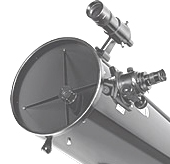
A well made reflecting telescope can offer the best view per the dollar of the faint, deep sky objects where light gathering power is essential. Light gathering power increases are more important and come quicker than one may think; consider that a 6"f8 - a 48" (122cm) long reflecting telescope may show objects about 335X fainter than the unaided eye, while the XT10 (with similar physical length) provides about 920X the light gathering power over the unaided human eye - in astronomy size can matter!
The Dobsonian telescope: The characteristic simple to use Alt-Azimuth mounting, use of a lightweight primary mirror and modestly priced components evolved in the 1970's with San Francisco sidewalk astronomer John Dobson. His goal was to get the most telescope possible into the hands of the amateur observer for the lowest relative cost. This arrangement has become known as the "Dobsonian" or "Dob".
The Dobsonian telescope consists of an optical tube assembly riding on a wooden alt-azimuth platform. The optical tube may be made of tube up to 18 or 20" in diameter. These tubes are typically made of Sonotube/cardboard, or plastic, or rolled metal. The Orion XT telescopes employ a rolled metal enameled tube finished internally in an anti reflection paint. This tube holds optical collimation well even with temperature or humidity changes. This thin wall tube permits the designer to select a smaller secondary mirror/obstruction. And this keeps the tube lighter weight and more compact than heavier Sonotube tubes. In the case of the better made larger Dobson telescopes (12-1/2 inch and larger), a Truss arrangement is employed in order to facilitate disassembly into a more manageable and compact package. Our best-made Dobson telescopes up to 10 inch aperture are those offered by Orion. While our larger Dobson telescopes include the Truss tube telescopes made by Astro-Systems.
Working with Gravity: The center of gravity lies directly over the center of rotation in both directions, so no matter to where the telescope is pointed, the weight is evenly distributed through the mount to the ground. This characteristic, and sound design results in almost complete elimination of unwanted vibration and oscillation; the inevitable downfall of many poor telescope mounts. Whereas in many economical telescopes the image seems to bounce around forever after the scope has been touched, this is not the case with well made Dobsonians.
In addition to getting some help from Newton's Law, Orion engineers developed the CorrecTension Friction Optimization system. This is a mechanism to adjust the tension or drag on the large five inch diameter altitude bearings to compensate for varying loads of eyepieces, cameras, finders, etc. A durable Nylon cord strap is attached to make it easy for the operator, even with a gloved hand in Winter to attach or release the springs. Throughout the range of movement, it remains free of annoying "sticktion" - moving smoothly and precisely from one position to another.
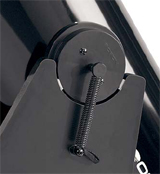 Left: The adjustable tension, spring loaded Trunnion arrangement of an Orion Dobsonian telescope. Note the 5" diameter Nylon altitude bearing surface riding on Teflon pads (19,941 bytes). Click on image for enlarged view (81,980 bytes).
Left: The adjustable tension, spring loaded Trunnion arrangement of an Orion Dobsonian telescope. Note the 5" diameter Nylon altitude bearing surface riding on Teflon pads (19,941 bytes). Click on image for enlarged view (81,980 bytes).
The XT10 Base includes a convenient Eyepiece Accessory Tray. This standard eyepiece holder since October 2002 is provided with slots for up to three 1.25 inch accessories, and one of 2" diameter. Furthermore, this tray is held in place by two keyhole shaped screw holes so that customers may easily slide the tray up and out to remove the tray for transport or if desired. To keep dew or other contaminants from marring eyepieces set on this tray Company Seven suggests you keep eyepiece caps in place and consider the use of dew prevention devices including our Kendrick heaters.
A Hands-On Telescope: The Dobsonian is a telescope you can push around - literally. You point it by simply nudging the tube up or down, and left or right by hand. Trunnions on the tube rotate on 5 inch diameter low-friction plastic bearings, allowing the telescope optical tube assembly to move up and down (altitude). The Base rotates horizontally (azimuth) around a center pivot. The motion on both axes is "buttery smooth," letting you guide the scope with just the lightest touch from one part of the sky to another. You do not need to loosen and tighten clamps when targeting objects, as you must with other mounts. Dobsonians are not equatorially mounted and so they are generally moved only by hand. While it is possible to add motors and computer control (to automatically find and track stars) it is generally not necessary or cost effective on smaller Dobsonians. Some companies do sell Dobs complete with tracking systems however, even these factory made tracking Dobsonians are not completely satisfactory for deep-sky astrophotography.
Nor do Dobsonian telescopes have setting circles for locating objects by their cataloged coordinates. Company Seven does offer optional electronic Encoder and digital display devices as aids to celestial navigation. Many people find the beauty of a Dob is in their no-frills simplicity - they just work. The Dobson design remains the first choice among serious deep sky observers, and it is not uncommon to find custom or home made 8" to 36" aperture "Dobs" in use at dark sky observing sites around the world.
The Orion SkyQuest™ Dobsonian telescopes sold by Company Seven in the 6" to 10" apertures provide excellent affordability and simplicity of operation, this makes these Dobsonians a great first telescope for entry into the hobby of amateur astronomy. Larger Dobs, though bulkier to transport and often requiring a step stool or ladder to reach the eyepiece, remain highly popular among experienced observers. Compared to similar-aperture Newtonians on their heavy equatorial mounts (and at times awkward eyepiece position), Dobsonians are delightfully economical. Experienced amateurs often claim that the best combination of portable telescopes for most persons pursuing astronomy would be an 18" to 20" Dobson, with a 6" Apochromatic Refractor!
|
|
|
|
|
|
|
|
|
|
|
|||
 |
 |
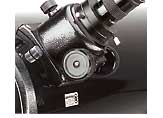 |
|
||
 |
|
||||
|
|
|
||||
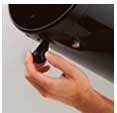 |
 |
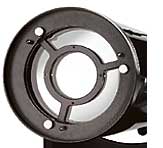 |
|
||
 |
|
||||
 |
|
||||
 |
|
|
|||
|
|
|
||||
Noteworthy features of the SkyQuest™ XT10 include:
-
A set of accessories provided to get you up and running on the first night out!
- Orion 25mm Plossl Eyepiece (50X providing 0.90 Degree Field of View)
- Orion 10mm Plossl Eyepiece (126X providing 0.39 Degree Field of View)
- Orion 9x 50mm Finderscope
- Quick Release three point Spring Loaded Adjustment Finder Mounting Bracket
- Collimation Cap (slips into focuser to help collimate telescope)
- Eyepiece Holder with three holes for 1.25" and one for 2" eyepieces or accessories
- Easy On-Off Plastic snap-on OTA Cover
Innovative Design!
- Lightweight rolled metal tube construction with cast Aluminum end rings
- Exterior is finished in durable Black gloss Enamel, interior in antireflection Black
- CorrecTension Friction Optimization system providing adjustable yet smooth friction/drag on Altitude Bearings
- Low-mass molded expertly finished Parabolic Primary Mirror made of Pyrex® a glass optimized for optical use
- Primary and secondary mirrors are aluminized and over coated with a transparent Silicon Monoxide protective coating assuring good longevity
- Adjustable Mirror Cell to support the Primary Mirror; redesigned in 2002 to provide maximum ventilation for faster cool-down time, and added easy spring-loaded collimation thumbscrews
- Optics hand finished and tested on a 125 line Ronchi
- Silky smooth cast and machined aluminum Focuser, with collimation adjustments
- Focuser Drawtube Lock
- Slip Fit 2 inch to 1.25" Reducer
- Convenient grip/carrying handle on the Base
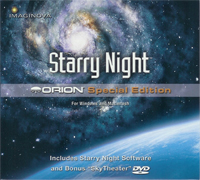 Receive a FREE Starry Night Special Edition software suite. Both the highly acclaimed planetarium software by Imaginova "Starry Night Special Edition" with a bonus "SkyTheatre" DVD are included FREE with purchase of any Orion-brand astronomical telescope from Company Seven.
Receive a FREE Starry Night Special Edition software suite. Both the highly acclaimed planetarium software by Imaginova "Starry Night Special Edition" with a bonus "SkyTheatre" DVD are included FREE with purchase of any Orion-brand astronomical telescope from Company Seven.
"Starry Night Special Edition" is a basic version of the more capable "Starry Night" version 5.0 astronomy software series; this software will help you learn the night sky, see what is up day or night, now or in past millennia, plan your observing sessions, and print out charts and information about the celestial wonders. The set also includes "SkyTheatre", a DVD by Imaginova so your television or PC becomes a spaceship on a voyage through our Solar System. The set is compatible with both Macintosh computers running OSX version 10.3 or later, and with Windows XP for PC. Your personal planetarium and guide to the night sky!
Left: CD-ROM "Starry Night Special Edition" with bonus "SkyTheatre" DVD suite (43,322 bytes).
Click on image to view enlargement (85,180 bytes).
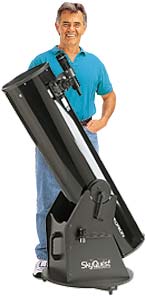 Left: Orion SkyQuest™ XT10 10"/25cm Dobsonian Reflector (14,045 bytes).
Left: Orion SkyQuest™ XT10 10"/25cm Dobsonian Reflector (14,045 bytes).
XT10 10"f Telescope Specifications:
|
Maximum Height Overall: Maximum Height to The Eyepiece: Length of Optical Tube Assembly: O.A. Diameter of Optical Tube Front Cell:
Focuser Design:
Weight of Optical Tube Assembly:
Effective Light Gathering Power: |
53 inches / 134.6cm (with lens cover) 48 inches / 122 cm 48 inches / 122 cm (with lens cover) 12.125 inches (38mm)
Rack and Pinion
35 lbs. (15.9 kg) |
For additional information about the Orion SkyQuest™ XT10 telescope
feel free to download the Orion illustrated
instruction manual from Company Seven's Library.
Note: this download size is 356,283 bytes (in Acrobat Reader ".pdf" format).
COMPANY SEVEN'S ASSEMBLY & TESTING SERVICE:
All of the information we provide on line and by phone or E-Mail to the customer, our expertise, our unrivaled showroom and museum (an increasing rare sight), and the fact that one may buy the basic instrument from us or elsewhere at about the same cost should be enough to persuade one to choose Company Seven. However, we do even better, we make it in your interest to buy from us.Orion has been quite good at making the factories overseas produce a great value. But once in a while something less than perfect slips by; a part is not glued just right, something is installed a bit off, or a component is damaged in transit. If you receive one of these telescopes and if you know enough to recognize an anomaly then it is a simple matter to call Orion or Company Seven for a prompt exchange or replacement parts. We both have very good reputations for after sale support and a money back guarantee.
-
"a series of subtle improvements that can transform an instrument into something wonderful"
When we assemble the XT we evaluate cosmetics, often cleaning off surplus glue or dirt. We install the Primary Mirror making those first and most time consuming adjustments to assure each optical and mechanical component is nominally installed. We are happy to provide you with the optional tools to collimate a telescope when it becomes necessary (after all some years from now you will probably want to pull the mirror for cleaning) and more importantly we will teach you how best to proceed. As we have worked on so many of these instruments we have developed a good sense of how a properly made and adjusted Focuser should feel. We know the tricks to make the telescope move smoother up and down, left and right. We know how to make it last longer - in fact we change out some components with superior alternatives. We find the quality control problems however, while we do not expect a "Rolls Royce" fit and finish on the XT telescopes, we work so that the telescope will perform as well as experience shows it can. And as we process the telescope we perform some tests that will reveal to our experienced eye whether or not the optics were made and collimated as they could be. And finally, we generate additional information that is provided to the owner; this will characterize the potential of the telescope for visual applications, and with an optional Equatorial Mount what the XT may accomplish photographically.
One will never read a sad tale from someone who actually bought their XT at Company Seven. We invite you to attend a Star Watch activity of any regional astronomy club and compare a telescope that bears the Company Seven acceptance label with those from elsewhere. In fact more and more we hear accounts of people at such events who bought their "Orion XT clone" elsewhere being convinced it was a great value until they felt the motion of our telescopes and gazed through the eyepieces we recommended.
Company Seven's customers tend to progress further in the hobby than others. This is in part because we are helping them as we wish someone else would have helped us. We are not archetypical salesmen, instead we are experts who can teach you about the instruments and provide the sincere good counsel.
-
"expert counsel brings value to a transaction, and profit should be the reward for a job well done"
SUGGESTED ACCESSORIES These are optional accessories that are not included with the telescopes that we highly recommend for your viewing pleasure and long term success:
- Guide book: "Backyard Astronomers Guide" or "Nightwatch" by Terrence Dickinson, or "Starware" by Phil Harrington. For the novice from age 8 to 15 or so up to adult. Good introductions to astronomy, the use of telescopes, and their accessories. Easy introductions to finding ones way around the night sky.
- Telrad illuminated sight: to aid one in finding and centering objects in the main telescope, and learn the sky by "star hopping" from one object to another
-
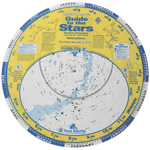 David H. Levy Guide to the Stars Planisphere If you are not familiar with the night sky then Company Seven recommends you buy a good simple Planisphere which makes it very easy for one to find out what constellations and major deep sky objects are overhead at any given time of the day or night.
David H. Levy Guide to the Stars Planisphere If you are not familiar with the night sky then Company Seven recommends you buy a good simple Planisphere which makes it very easy for one to find out what constellations and major deep sky objects are overhead at any given time of the day or night.
The night sky is mapped with the Constellations being those patterns recognizable to man since time immemorial. Constellations can be thought of as countries or states on a world map, where if you seek the Grand Canyon then you know to find Arizona. While in the night sky when one seeks the Great Nebula then one looks toward the Constellation Orion. The Planisphere is a two piece assembly consisting of one disc with a chart of the entire night sky, and an attached overlay disc with a transparent window and surrounding mask to simulate the horizons. The overlay is dialed to line up its local time indicator marks with the Month and Day printed around the edge of the chart disc, and so when properly set this will reveal what parts of the sky may be seen at any time of the year. The print is easy to read under day or red light.
-
 Once you begin to understand the way the night sky works with your Planisphere, the next step we suggest is to buy the Orion DeepMap 600 folding laminated Star Chart, edited by Steve Peters. Originally printed in 1997, the revised "Orion DeepMap 600" is among those indispensable publications that Company Seven recommends to anyone interested in learning their way around the night sky. The editor Steve Peters conceived of this as a very helpful device for anyone interested in astronomy and who may little or no observational experience. This has become the most popular chart of the night sky among our customers who are new to the hobby and who buy a telescope or binocular and now seek out what to see and when. This is often bought as a economical but valued and durable gift.
Once you begin to understand the way the night sky works with your Planisphere, the next step we suggest is to buy the Orion DeepMap 600 folding laminated Star Chart, edited by Steve Peters. Originally printed in 1997, the revised "Orion DeepMap 600" is among those indispensable publications that Company Seven recommends to anyone interested in learning their way around the night sky. The editor Steve Peters conceived of this as a very helpful device for anyone interested in astronomy and who may little or no observational experience. This has become the most popular chart of the night sky among our customers who are new to the hobby and who buy a telescope or binocular and now seek out what to see and when. This is often bought as a economical but valued and durable gift.
Fully color illustrated, it is the first-ever star chart that folds up like a road map! DeepMap 600 shows the positions of more than six hundred of the finest celestial objects visible from the Northern Hemisphere. Each of these objects are plotted on a giant 33 x 21 inch full-color star chart by world-renowned celestial cartographer Wil Tirion. But what really makes this star chart invaluable is its convenience; it folds "accordion style" into a thin, pocket-size 4-¾ x 10-½ inches format - just like a road map!
The chart is easy to read, and you will see more of the night sky when reading this with an optional red flashlight
- Red LED Flashlight such as the Rigel Skylite to help one set up and use a telescope, and to read charts or a planisphere without adversely impacting the observers night vision.
- AstroSystems Collimating tool set, these are provided with good with instructions. Or for those who want a very accurate, and easy to use collimator then we recommend you consider our holographic Glatter Laser Collimator devices; even though documentation is included these devices require some training of the user to obtain best results, and our staff is more than capable to help you learn how to use these.
- Neutral Density and Color Filters to reduce the brightness of the Moon and Planets, and highlight subtle features.
- Sky Light Pollution Rejection Filter to reduce the greenish or golden background glow from city lights and darken the sky background - aid seeing faint Nebulae.
- Improved 2" to 1.25" accessory adapter with non-marring clamp to securely hold eyepiece, threaded to accept 48mm filters so that you will only need to buy one standard size filter for use with either 1.25" or 2" eyepieces.
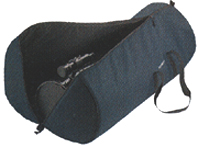
- Orion fitted Carrying Bag for safer, and more convenient transport the telescope optical tube assembly. Keep in mind that these are very convenient and lightweight bags, but are not suitable for shipping a telescope.
- Eyepieces: Orion includes two eyepiece with this telescope, 10mm and 25mm Plossls. Typically astronomers will wish to initially set up the telescope with at least two or three 1.25" or 2" eyepieces to address:
- Low magnification: for views of the faint deep sky objects a 32mm to 35mm focal length eyepiece.
- Middle Magnification eyepiece - usually between 80 to 120X, for views of the full Moon, Star Clusters, etc.
- High magnification: 200X or more for views of the planets
Eyepiece designs such as the Plossl, Orthoscopic are acceptable. If you object to less than perfect images particularly at the edge of the field, and if you require long eye relief (distance from lens to the eye) to accommodate spectacles, then Company Seven recommends eyepieces of advanced designs such as those pioneered by Al Nagler, founder of the TeleVue company. TeleVue's advanced designs include the "Nagler", "Radian", or "Panoptic" series eyepieces. These oculars will provide the widest clear, and flat field images bringing out the most in your telescope (and many other) telescopes. Wider field of views are also desirable since as the Earth rotates and objects drift across the field of view, a wide angler ocular shows an object for some time longer before having to adjust the telescope.
Please refer to the brochure and the test report/data from Company Seven enclosed with our telescopes for detailed characterizations of suggested eyepieces:
Eyepiece Magnification Actual field of view Exit pupil 40mm Plossl 31x 1.23 degrees 8.10mm 35mm Panoptic 36x 1.77 degrees 7.08mm 32mm Plossl 39x 1.23 degrees 6.48mm 25 Plossl (included) 50x 0.90 degrees 5.06mm 17mm Nagler 74x 1.11 degrees 3.44mm 15mm Plossl 84x 0.58 degrees 3.04mm 12mm Radian 105x 0.58 degrees 2.43mm 9mm Plossl (included) 139X 0.35 degrees 1.82 mm 6mm Radian 209x 0.29 degrees 1.21mm - Low magnification: for views of the faint deep sky objects a 32mm to 35mm focal length eyepiece.
- Equalizer: A slip fit machined bronze, heavy 2 to 1.25 inch diameter reducer adapter. Helps to keep telescope balance when switching to and from light and heavy accessories and eyepieces. Particularly helpful when using telescope with Alt-Azimuth mounts.
- Barlow or TeleVue "Powermate" Lens: Company Seven suggests you consider any of a number of 1.25 inch or 2 inch diameter Barlow lenses that we offer to double or more than triple your magnification. Furthermore, these accessories can project an image farther from the focuser to attain focus with most 35mm SLR cameras, optional accessories such as binocular viewers, etc. Contact Company Seven for suggestions on how to to best meet your goals.
- These XT telescopes put the eyepiece at position that is only about 4 feet (1.2 meters) from the ground. Since most of our customers are taller than that, they will find it uncomfortable to stand bent over to observe for extended periods. For a much more enjoyable and comfortable observing experience, Company Seven recommends the Observing Chair; this is our most comfortable, flat folding, adjustable height seat. It is not inexpensive, but is so practical and can be used for camping or other times when a comfortable portable seat is desired.
- Equatorial Mount: being constructed with a metal tube, at some time in the future you could buy a good quality equatorial mount and improve the usability of this telescope to attain its high magnification potential. A telescope of this length and torque requires a good quality, rigid platform to support it. We recommend you consider:
- Losmandy Hollywood General Machining Model GM-8 mount.
- Losmandy Hollywood General Machining Model G-11 mount.